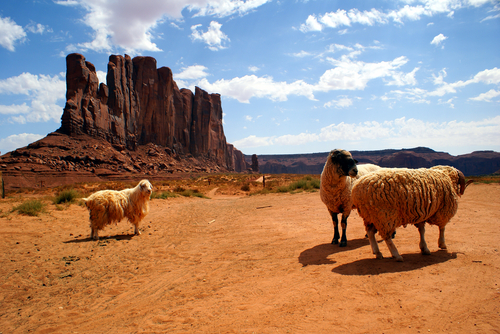Traditional Navajo Lifeways
 Navajo lifeways reflect a constellation of Athapaskan, Puebloan, and European cultural traits. Reflecting their Athapaskan roots are Navajo beliefs about death, the emphasis on individuals and shamanism in their ceremonies, and their use of conical dwellings. Traits adopted from the Pueblo Indians include farming, pottery, weaving, and the use of a clan system. And finally, from the Europeans (but via the Pueblo Indians) they obtained livestock (especially sheep) and certain agricultural crops such as peaches and wheat.
Navajo lifeways reflect a constellation of Athapaskan, Puebloan, and European cultural traits. Reflecting their Athapaskan roots are Navajo beliefs about death, the emphasis on individuals and shamanism in their ceremonies, and their use of conical dwellings. Traits adopted from the Pueblo Indians include farming, pottery, weaving, and the use of a clan system. And finally, from the Europeans (but via the Pueblo Indians) they obtained livestock (especially sheep) and certain agricultural crops such as peaches and wheat.
Traditional Navajo subsistence is based primarily on sheep-herding and farming. Sheep were considered an important source of power; the person who wielded the most power was usually the person who had the most and best sheep. Until the mid-nineteenth century, Navajo lived in dispersed settlements and followed a bi-seasonal settlement pattern that rotated between summer and winter homes.The basic economic and social unit was the matrilocal extended family, which was organized around the head mother, the sheep herd, and a land-use area. Within this group, sheep were individually owned but jointly managed and fields were jointly used. The tasks of lambing and shearing were shared by the entire residence group.
Above the extended family was a loosely knit unit called the outfit. The outfit consisted of a group of relatives who lived near one another and who cooperated for certain ceremonial or other purposes. The largest kin group was the matrilineal clan but, other than regulating marriage (one could not marry within a their own or a related clan), the clan had few functions. The Navajo did not share any sense of a tribal consciousness until after their return from Bosque Redondo.
Sheep on the Navajo reservation
Source - http://www.shutterstock.com/pic.mhtml?id=16414153&src=id
Click on next page to continue.
